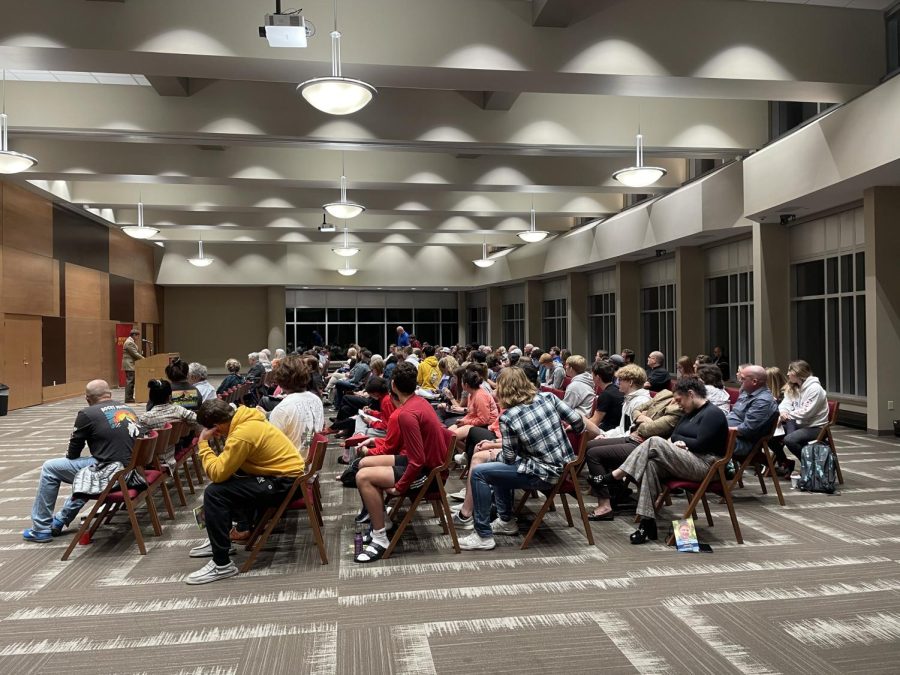Matthew Simpson lecture series: the religious right
100 or so Indianola community members gather in Hubbell Hall for the Matthew Simpson Lecture.
October 12, 2022
Roughly 100 students, staff and Indianola community members gathered in Hubbel Hall on Thursday, Oct. 6 to hear Randall Balmer’s lecture on the “religious right.”
A prize-winning historian in American religion, Balmer graduated from Hoover High School in Des Moines and went on to earn his Ph.D. from Princeton. He has taught at some of the nation’s top colleges and universities including his alma mater, Yale, Northwestern and Columbia.
Balmer’s lecture focused on racism, religion and the greed for power in the political system; all leading to explain how and why abortion entered the forefront of political debate in the late 1970’s, post Roe v. Wade.
“If anyone has followed my work over the years you know that one of my aspirations has been to call evangelicals back to their roots,” Balmer said in his opening monologue. “The evangelicalism I knew in 1972 was largely apolitical.”
There is a common misconception that all religions are, and always have been, pro-life. The truth is, many denominations did not have a general stance on the issue until recently. Evangelicals specifically, were the focus of the lecture.
Raised in the religion himself, when Balmer embarked on his own political journey he was surprised at what he found.
“I was unprepared for the passion surrounding the abortion issue. Yes, I was aware that leaders of the religious right were insisting that oposition to abortion had motivated their political activism,” he said. “But I never recall the issue ever discussed during my evangelical childhood. Never.”
What puzzled Balmer deeply was when abortion became an evangelical issue, and how did he miss it?
“I enrolled at an evangelical college in the fall of 1972, and the Roe v. Wade decision on Jan. 22 of ‘73 elicited not so much as a whimper at my evangelical school,” Balmer said. “To the extent that the abortion issue arose at all was typically dismissed as a Catholic concern, one not worthy of evangelical attention.”
Upon extensive research and first-hand experiences in his own political journey, Balmer believes he was ultimately able to pin-point the catalyst of the issue at hand.
In 1971 in Green v. Connally, a landmark decision concluded any racially segregated private school would no longer be eligible for tax exemption. For evangelicals and Christians alike, this meant they could no longer get public support for being racist. The religious right needed a new issue to piggy back their campaigns on.
“Trying to make sense of what I’ve seen, I wondered if evangelicals had developed some sort of visceral identification with the fetus,” Balmer said. “Through much of the 20th century, evangelicals had felt alienated from a society they came to regard as both corrupt and corrupted.”
Essentially, evangelicals felt out of place in this new age, until they discovered new-found safety and comfort in political allyship with the religious right.
“The symbolism of the fetus was compelling because it represented the displacement evangelicals felt in a pluralist world that they were convinced had turned against them and their [racist] values,” Balmer said. “What embodied their alienation and their vulnerability better than anything else, was the fetus which they characterized as pure and innocent.”
Evangelicals as a whole displaced their loss of community and sense of confusion upon an entirely unrelated issue. Originally, abortion was not an issue that mobilized evangelical leaders; anti-discrimination laws ultimately galvanized this group.
Of course, not everyone agrees with this analysis, which Balmer was quick to point out. However, to provide more information and deeper analysis into the religious right, Balmer released, “Bad Faith: Race and the Rise of the Religious Right.”
The history of political issues may not be entirely compelling to most, but their effect can be seen by all.














